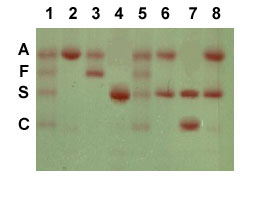Your blood gets its red color from a protein called hemoglobin which also helps transfer oxygen to different cells of your body. There are some normal and some abnormal hemoglobin types in human body, and if the abnormal hemoglobin exceeds the amount of normal hemoglobin, this will result in a blood disorder. A test called hemoglobin electrophoresis helps measure the types of hemoglobin in your blood. Keep reading to learn more about the test and what it indicates when it's not normal.
What Is a Hemoglobin Electrophoresis?

A hemoglobin electrophoresis is a test performed to measure the types of hemoglobin present in your bloodstream. Hemoglobin is a protein inside your red blood cells and helps carry oxygen and supply it to the cells. This protein comes in different molecular forms, some of which are normal and some are abnormal. Healthy hemoglobin can carry and release oxygen in an efficient way, while abnormal molecular forms fail to do so. Hemoglobin F and hemoglobin A are the two most common types of normal hemoglobin. Hemoglobin F is found in newborns and fetuses and is replaced by hemoglobin A after birth. While the most common types of abnormal hemoglobin are hemoglobin S, C, D, E and M. If you inherit the genes that lead to the over-production of an abnormal type of hemoglobin or under-production of normal hemoglobin, you will end up developing a blood disorder. The most common types of blood disorders are sickle cell disease and thalassemia.
- Sickle cell disease: You will develop this disease if your body is producing too much hemoglobin S. In this disease, your red blood cells will have a sickle shape, which make them brittle. They break down easily and clog small blood vessels to cause several complications.
- Thalassemia: It is a combination of different genetic blood diseases, which occurs the production of certain type of hemoglobin is abnormal, such as too little of hemoglobin A and too much of hemoglobin F.
Different hemoglobin types have different electrical charges, and this provides the base for the hemoglobin electrophoresis process. The process involves passing an electrical current through the hemoglobin in a blood sample to separate different hemoglobin types. The separation occurs at different rates for different types of hemoglobin. These types that form bands can be compared with the pattern found in a normal blood sample.
When Is a Hemoglobin Electrophoresis Needed?
Your doctor may order a hemoglobin electrophoresis test to diagnose certain diseases, often called hemoglobinopathies. These diseases involve abnormal hemoglobin production, such as thalassemia and sickle cell disease. Your doctor may also order the test when you have a family history of certain hemoglobin abnormalities. A child may also need hemoglobin electrophoresis when he/she has anemia due to a cause other than iron deficiency. In many states, it is necessary for parents to have a hemoglobin electrophoresis test done because it's part of a series of newborn screening blood tests. This also helps diagnose sickle cell anemia early, which helps prevent life-threatening complications.
How Is the Test Performed?
Your doctor will start by cleaning the site with a swab of rubbing alcohol. A small needle will be inserted into your vein and your blood will be collected in a tube attached to the needle. Your doctor will cover the site with a gauze pad after they have collected enough blood. Your blood sample will then go to a laboratory for analysis.
After then, a lab specialist will use a process called electrophoresis to pass an electrical current through your blood sample to find different types of hemoglobin. They draw a conclusion after comparing the results of your sample with a healthy sample.
Understanding the Results
After making a comparison, a report will be compiled, which will provide your doctor with enough information to proceed in the right direction. Here's a bit more about what you will find on your report after your hemoglobin electrophoresis test.
1. Normal Results
In adults, the percentages of certain hemoglobin molecules should be:
|
Hemoglobin Molecules |
Percentage |
|
Hb A |
95% to 98% |
|
Hb A2 |
2% to 3% |
|
Hb F |
0.8% to 2% |
|
Hb S |
0% |
|
Hb C |
0% |
The hemoglobin molecules will have different percentages in infants and children as listed below:
|
Hemoglobin Molecules |
Percentage |
|
Hb F (Newborn) |
50% to 80% |
|
Hb F (6 months) |
8% |
|
Hb F (Over 6 months) |
1% to 2% |
If your hemoglobin electrophoresis test shows results within these values, your test is normal. Just bear in mind that normal value ranges may be a bit different in different laboratories. It is important to talk to your doctor to understand if your test is normal or not.
2. Abnormal Results
If a large amount of abnormal hemoglobin is present in your blood sample, you may have an underlying medical condition, such as sickle cell anemia, rare hemoglobinopathy, thalassemia or hemoglobin C disease. You should inform your doctor if you've had a blood transfusion within last three months of your hemoglobin electrophoresis because it may produce false normal or abnormal results.
After the Test
After a hemoglobin electrophoresis test, your doctor will read your report and see if it indicates any abnormality. Your treatment will depend on the underlying health problem. For instance, you may have to take folic acid supplements to treat hemoglobin C disease. A bone marrow transplant is necessary to treat sickle cell anemia. Usually, the natural and severity of thalassemia will determine the treatment option for you. Your doctor will also explain how to manage your disorder by making certain changes to your lifestyle.
